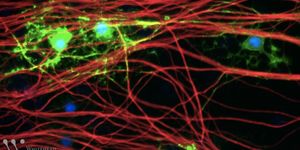Revealing the Network of Neurons in the Heart
The body's internal organs, including the heart, are controlled in part by a network of nerves known as the autonomic nervous system (ANS). The ANS is linked to the intrinsic cardiac nervous system (ICN), which is thought to help regulate the function of the heart. Researchers have now used gene expression data to create a three dimensional, digital model of the ICN of the rat. The work, which has been reported in the journal iScience, can illuminate the roles of different clusters of neurons in the heart. It may also aid in the creation of similar virtual maps for other organs.
"Many cardiologists aren't even aware there are neurons in the heart, let alone that they are critical to heart health," said the senior study author James Schwaber, director of the Daniel Baugh Institute for Functional Genomics and Computational Biology at Thomas Jefferson University. "By using this 3D reference space, we can build a comprehensive picture of the heart's structure which is foundational to address various health concerns."
With a diamond knife, thin slices of rat hearts were generated and images of the slices were used to lay the groundwork for a 3D model. Individual neurons were precisely dissected from the heart, and their positions were recorded. Gene expression profiles were generated using the individual neurons that were removed. Taken together, this data made a comprehensive map of the neural network of a rat heart.
"With the spatial mapping of the gene expression, we can begin to discuss the precise roles that these neurons play. Do separate clusters of the ICN neurons have different functions, or do they work into an integrated way to influence heart health? Now we can address these questions in [a] way that wasn't possible before," said study co-author Zixi Jack Cheng, a cardiovascular anatomist and physiologist at the University of Central Florida College of Medicine.
The researchers found that the ICN has an intrinsic pattern. The study authors wrote that "The majority of neurons are on the posterior or dorsal surface of both atria, but more prominently on the left side, extending to the coronary sulcus separating the atria from the ventricles."
Though it used data from rats, the scientists are hopeful it will teach us more about human biology. "Evaluating these cardiac neurons from an anatomical and molecular perspective may help us better understand their function and develop therapies that can produce these protective effects of the vagus nerve onto the hearts of more patients," said study co-author Jonathan Gorky, a recent M.D./Ph.D. graduate from Thomas Jefferson University and medical resident at Massachusetts General Hospital.
"Now that we have a comprehensive map of the heart, the way we pursue bioelectronic medicine will significantly change as we have information available at a level of resolution that just wasn't accessible before this," added study co-author Rajanikanth Vadigepalli, a systems biologist at Thomas Jefferson University.
Learn more about the ICN from the video.
Sources: AAAS/Eurekalert! via Cell Press, iScience








